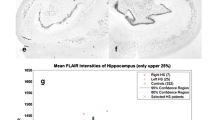Abstract
Volumetric measurement of the hippocampus is of use in localisation of lesions causing focal epilepsy and in lateralisation of epilepsy due to mesial temporal sclerosis. However, it is time consuming and requires specialised equipment. Hence, we compared volumetric measurement with visual detection of hippocampal asymmetry by five trained observers. MRI studies of 19 neurologically normal subjects and of 34 consecutive patients with epilepsy and hippocampal volume ratios below the lowest normal value were employed. Agreement between visual and quantitative diagnoses was 59% for all subjects (ϰ=0.38) and 65% for those with volumetric hippocampal asymmetry. Disagreements in visual and volumetric lateralisation of hippocampal asymmetry were relatively uncommon. Visual estimates of the extent of hippocampal involvement and the observers' confidence in the diagnosis influenced the accuracy of visual inspection. However, discordance in diagnoses occurred even when confidence in the visual diagnosis was high. Reliable visual detection occurred for hippocampal volume ratios below 0.7, suggesting that visual determination of hippocampal asymmetry is of greatest clinical value in the lateralisation of seizure foci in patients already selected for the presence of intractable temporal lobe epilepsy. Volumetric measurements are particularly important if hippocampal asymmetry is used for seizure localisation in groups of patients with temporal or extratemporal epilepsy.
Similar content being viewed by others
References
Babb TL, Brown WJ (1987) Pathological findings in epilepsy. In: Engel J Jr (ed) Surgical treatment of the epilepsies. Raven Press. New York, pp 511–540
Bruton CJ (1988) The neuropathology of temporal lobe epilepsy. Oxford University Press. Oxford, pp 1–158
Margerison JH, Corsellis JAN (1966) epilepsy and the temporal lobes. A clinical, electroencephalographic and neuropathological study of the brain in epilepsy, with particular reference to the temporal lobes. Brain 89:499–530
Falconer MA, Serafetinides EA, Corsellis JAN (1964) Etiology and pathogenesis of temporal lobe epilepsy. Arch Neurol 10:233–248
Dam AM (1980) Epilepsy and neuron loss in the hippocampus. Epilepsia 21: 617–629
Jackson GD, Berkovic SF, Duncan JS, Connelly A (1993) Optimizing the diagnosis of hippocampal sclerosis using MR imaging. AJNR 14:753–762
Spencer SS, McCarthy G, Spencer DD (1993) Diagnosis of medial temporal lobe seizure onset: relative specificity and sensitivity of quantitative MRI. Neurology 13:2117–2124
Cook MJ, Fish DR, Shorvon SD, Straughan K, Stevens JM (1992) Hippocampal volumetric and morphometric studies in frontal and temporal lobe epilepsy. Brain 115:1001–1015
Jack CR, Sharbrough FW, Twomey CK, Cascino GD, Hirschorn KA, Marsh WR, Zinsmeister AR, Scheithauer B (1990) Temporal lobe seizures: lateralisation with MR volume measurements of the hippocampal formation. Radiology 175:423–429
Cendes F, Leproux F, Melanson D, Ethier R, Evans A, Peters T, Andermann F (1993) MRI of amygdala and hippocampus in temporal lobe epilepsy. J Comput Assist Tomogr 17:206–210
Adam C, Baulac M, Saint-Hilaire J-M, Landau J, Granat O, Laplane D (1994) Value of magnetic resonance imaging-based measurements of hippocampal formations in patients with partial epilepsy. Arch Neurol 51:130–138
Jackson GD, Berkcvic SF, Tress BM, Kalnins RM, Fabinyi GCA, Bladin PF (1990) Hippocampal sclerosis can be reliably detected by magnetic resonance imaging. Neurology 40:1869–1875
Cohen J (1960) A coefficient of agreement for nominal scales. Educ Psychol Meas 20:37–46
Landis JR, Koch GG (1977) The measurement of observer agreement for categorial data. Biometrics 33:159–174
Jack CR, Sharbrough FW, Cascino GD, Hirschorn KA, O'Brien PC, Marsh WR (1992) Magnetic resonance imagebased hippocampal volumetry: correlation with outcome after temporal lobectomy. Ann Neurol 31:138–146
Lencz T, McCarthy G, Bronen RA, Scott TM, Inserni JA, Sass KJ, Novelly RA, Kim JH, Spencer DD (1992) Quantitative magnetic resonance imaging in temporal lobe epilepsy: relationship to neuropathology and neuropsychological function. Ann Neurol 31: 629–637
Trenerry MR, Jack CR, Ivnik RJ, Sharbrough FW, Cascino GD, Hirschorn KA, Marsh WR, Kelly PJ, Meyer FB (1993) MRI hippocampal volumes and memory function before and after temporal lobectomy. Neurology 43:1800–1805
Jackson GD, Kuzniecky RI, Cascino GD (1994) Hippocampal sclerosis without detectable hippocampal atrophy. Neurology 44:42–46
Meiners L, Stevens J (1995) Validity of MR volumetry of the hippocampus in clinical studies (abstract). Neuroradiology 37:163
Author information
Authors and Affiliations
Rights and permissions
About this article
Cite this article
Reutens, D.C., Stevens, J.M., Kingsley, D. et al. Reliability of visual inspection for detection of volumetric hippocampal asymmetry. Neuroradiology 38, 221–225 (1996). https://doi.org/10.1007/BF00596533
Received:
Accepted:
Issue Date:
DOI: https://doi.org/10.1007/BF00596533




